
Mars: The Ultimate Voyage
It is humanity’s most ambitious journey—one that will take us farther from home than ever before. Mars: The Ultimate Voyage carries audiences across millions of miles to the Red Planet, revealing what it will take for humans to survive and thrive on this distant world. Through stunning fulldome imagery and immersive sound, the show invites viewers to leave Earth’s cradle behind and experience the wonder and peril of deep space.
Every second of the mission is a test of endurance and ingenuity. Astronauts must face isolation, radiation, and months of travel through the silent void—all while relying on creativity, communication, and collaboration to overcome the unknown. Guided by real NASA science, Mars: The Ultimate Voyage explores how humans are preparing for this two-year odyssey, from designing life-sustaining habitats to building the resilience needed to live and work millions of miles from Earth.
Created by Morehead Planetarium and Science Center in collaboration with NASA and the Bell Museum, and funded by NASA’s TEAM II program, this extraordinary production blends discovery with imagination. Mars: The Ultimate Voyage celebrates not only the technology that will get us there, but the spirit that drives us to reach beyond our world—to explore, to adapt, and to take the ultimate voyage.
Show Length: [25 minute show + 5 to 15 minute sky tour]
Intended Audience: Children/Families, Adults

Antarctica
It is a land of mystery and yet what happens here affects every single one of us. With never-before seen footage, our story brings audiences to the farthest reaches of this wild and majestic continent. It is the coldest, driest and windiest place on Earth with the roughest oceans and yet, weird and wonderful creatures thrive here in astounding abundance. Antarctica is the perfect fit for the Giant Screen.
Using the latest underwater filming techniques, dive beneath sea ice, more than 6 feet thick, to experience the alien world of its seafloor – thousands of purple starfish scuttling to escape being entrapped by growing ice and elaborate jellyfish dancing a deadly dance. Swim alongside playful seals, soar above mountain peaks and vast penguin colonies and witness the largest congregation of fin and humpback whales ever filmed.
Although so remote from us, Antarctica and its surrounding Southern Ocean play a vital role for the entire planet, regulating ocean currents, sea levels and its wildlife-filled waters can absorb huge amounts of carbon. New science is revealing that dramatic changes are occurring and rapidly warming this pristine land of snow and ice. No one owns Antarctica but it will take global cooperation and collaboration to protect it and ensure the future health of our planet.
Show Length: [45 minute show + 5 to 15 minute sky tour]
Intended Audience: Children/Families, Adults
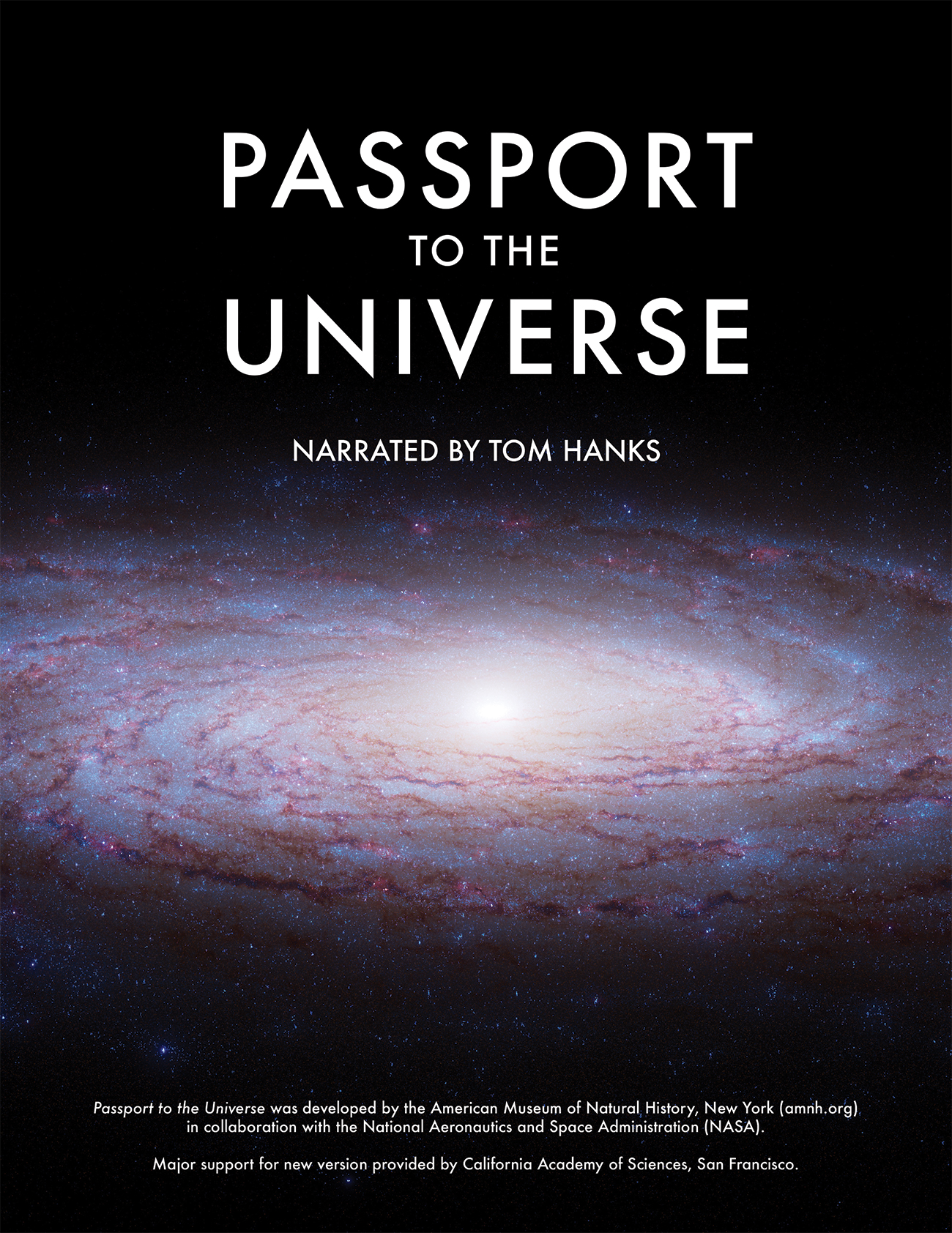
Passport to the Universe
Narrated by Tom Hanks, Passport to the Universe takes you on a thrilling journey through the observable universe. Fly beneath the rings of Saturn, float through the heart of the Orion Nebula, and plunge into a black hole during this captivating introduction to cosmology.
Taking audiences on an unforgettable voyage of billions of light-years, Passport to the Universe is an incredible journey from our home planet and the Milky Way galaxy to the edge of the universe. Audiences fly beneath the rings of Saturn, into the heart of the Orion Nebula, and out into the vastness of the observable universe, experiencing these and other stunning cosmic destinations as never before possible. Using real science and cutting-edge technology to create immersive experiences that educate and inspire, Passport to the Universe is an unprecedented virtual tour that takes audiences to the limits of the universe and back again.
Passport to the Universe was developed by the American Museum of Natural History in collaboration with the National Aeronautics and Space Administration (NASA).
Show Length: [20 minute show + 5 to 15 minute sky tour]
Intended Audience: Children/Families, Adults

The Great Barrier Reef
Every year millions of visitors travel by way of fins, flippers and feet to see one of the seven wonders of the natural world: the Great Barrier Reef. It's a living treasure trove of biodiversity. There is still so much to learn and knowledge is the key to understanding more about this living Eden. A thriving metropolis populated by a cast of characters straight out of an adventure novel – heroes, bad guys, sidekicks, lovers and clowns – they’re all players in this vast underwater drama. Today, a new generation of reef guardians are committed to protecting this marine reserve, making a difference and sharing their knowledge of this extraordinary ecosystem, the beating heart of the reef. Learn how this amazing sanctuary has endured for thousands of years and will continue to do so far into the future.
Show Length: [40 minute show + 5 to 15 minute sky tour]
Intended Audience: Children/Families, Adults

Capcom Go!
An immersive, historical documentary that showcases the achievements of the Apollo program and what it took to put the first human on the Moon. It introduces a new generation to the immense challenges they overcame and will inspire them to become the explorers, designers, engineers, thinkers and dreamers of the future.
On July 20th 1969, 600 million people around the world gathered to witness a historic moment of human achievement broadcast live from the Moon. "That's one small step for man, one giant leap for mankind", Neil Armstrong.
The world celebrated as the astronauts took their first steps on the Moon. But few people were aware of just how huge an effort it had taken to get them there. These Apollo 11 astronauts were just 3 of nearly 400,000 people who had worked over ten years towards this goal.
Show Length: [26 minute show + 5 to 15 minute sky tour]
The world celebrated as the astronauts took their first steps on the Moon. But few people were aware of just how huge an effort it had taken to get them there. These Apollo 11 astronauts were just 3 of nearly 400,000 people who had worked over ten years towards this goal.
Show Length: [26 minute show + 5 to 15 minute sky tour]
Intended Audience: Children/Families, Adults

Space: The New Frontier
An entire generation came of age with the indescribable awe of landing on the Moon — and the ensuing Golden Age of Space has changed our world forever for the better. More than 50 years later, what is the next step for humankind? A second golden age of space has quietly dawned on us, with new hope for humanity as a spacefaring species.
In the quest to make human spaceflight accessible within in a decade, not a century, and ultimately affordable to ordinary citizens, leading innovators, entrepreneurs, engineers, and daredevils are locked in a race into the unknown. From self-assembling habitats, commercial space stations, launching rockets without fuel to building the Lunar Gateway to deep space, history is in the making as we speak.
In the quest to make human spaceflight accessible within in a decade, not a century, and ultimately affordable to ordinary citizens, leading innovators, entrepreneurs, engineers, and daredevils are locked in a race into the unknown. From self-assembling habitats, commercial space stations, launching rockets without fuel to building the Lunar Gateway to deep space, history is in the making as we speak.
Show Length: [41 minute show + 5 to 15 minute sky tour]
Intended Audience: Children/Families, Adults

Sea Lions: Life by a Whisker
Between a jagged cliff face and a roaring ocean, lives a colony of Australian Sea Lions. In an environment equally as harsh as it is beautiful, be immersed in a classic coming of age tale guided by one of Australia’s most unique, intelligent, and playful animals. Take an intimate journey inside the colony where a life of great intimacy, tenderness, and clumsiness, must often give way to a life of great sacrifice and bravery. Dive into the world of a rare Australian Sea Lion pup – and meet the people that are trying to save her species.
Show Length: [44 minute show + 5 to 15 minute sky tour]
Intended Audience: Children/Families, Adults

One World, One Sky: Big Bird’s Adventure
Discover the night sky with Big Bird, Elmo and their new friend from China, Hu Hu Zhu.Elmo and Big Bird live in the United States and Hu Hu Zhu lives far away in China, but they discovered that they still see the same stars at night! The word for star in Chinese is “xing xing” (pronounced sing sing). How many “xing xing” do you see in this sky?
One World, One Sky is a brilliant spectacle of light and color as the furry friends watch the stars twinkle over Sesame Street. Children attending the show can interact as they watch, drawing constellations and counting the time it takes the sun to set. The show aims to nurture a child's natural sense of wonder about the night sky while forging cross-cultural connections, and bridging kids across nations through a common bond in learning about the sky together.
Languages Available: English and Spanish
Teacher's Guide: OneWorldOneSky_edguide.pdf
Show Length: [27 minute show + 5 to 15 minute sky tour]
Intended Audience: Children, ages 3-5

Secret of the Cardboard Rocket
Adventure through the solar system in the Cardboard Rocket! Travel with two children and their navigator, the talking astronomy book. Visit the Sun, the planets, the Moon and more!
Join two children on a magical journey through the Solar System, aided by a talking astronomy book, a cardboard rocket, and a vivid imagination. In the most dynamic fashion possible, the young star travelers show you what could only be dreamed of before. From the boiling surface of the sun to the icy rings of Saturn, children of all ages will be mesmerized by the incredible scenery in motion. Discover the wonder of discovery in Secret of the Cardboard Rocket.
Teacher's Guide: cardboard_rocket_edguide.pdf
Show Length: [26 minute show + 5 to 15 minute sky tour]
Intended Audience: Families/Children ages 5-8

The Little Star That Could
The Little Star That Could is a story about Little Star, an average yellow star in search of planets of his own to protect and warm.
Along the way, he meets other stars, learns what makes each star special. He discovers that some stars are alone, but others are found in pairs or groups of three or more. Very large groups are called star clusters and are very far away. And the largest collections of stars are called galaxies like the one he lives in – the Milky Way.
Eventually, Little Star finds his planets, and each is introduced beginning with Mercury, the closest one to him. Each planet in turn provides basic information about themselves explaining why they each think they are special. Once he has met them all, the Little Star asks for a roll call and discovers that they all belong to his very own Solar System.
Show Length: [36 minute show + 5 to 15 minute sky tour]
Intended Audience: Families/Children ages 5-7
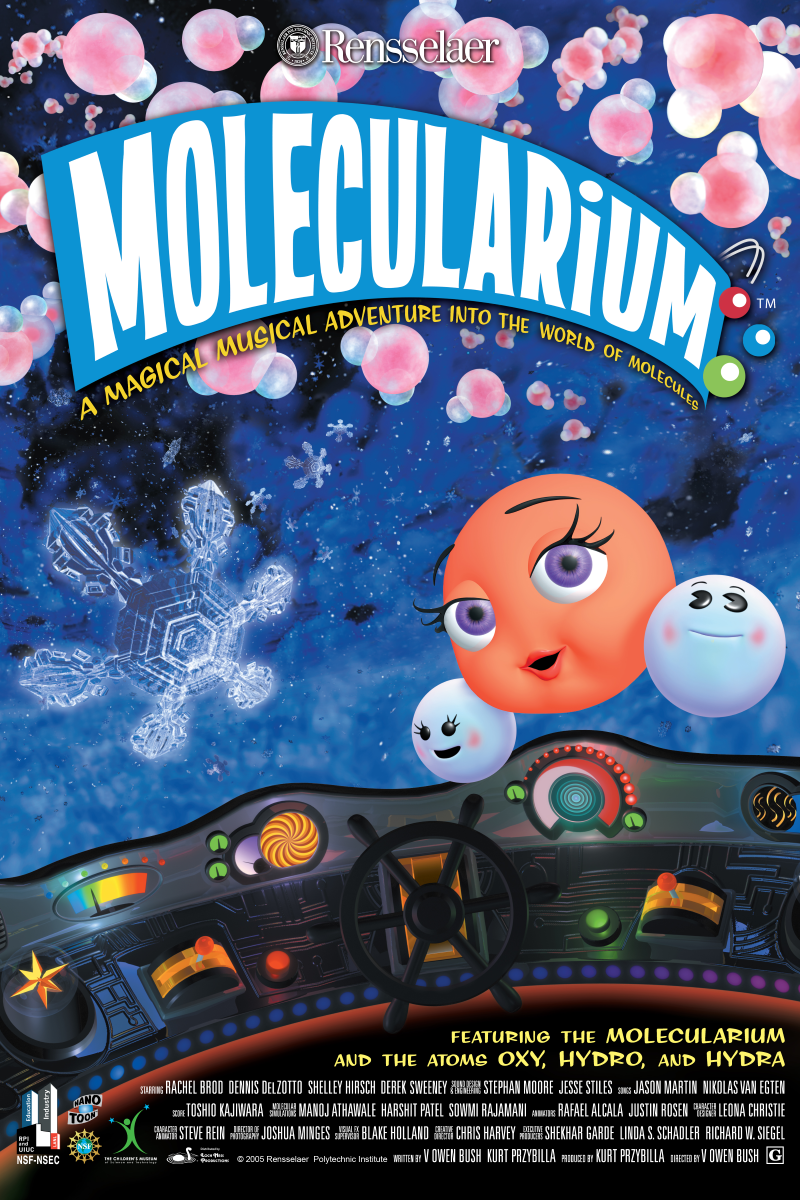
Molecularium
Welcome to Molecularium, a magical, musical adventure into the world of molecules! This show is an exciting new animation created to spark interest in the atoms and molecules that constitute our world.
Molecularium: Riding Snowflakes, the award-winning digital dome experience, is a science lesson, a thrill-ride, and a magical musical adventure in a world of atoms and molecules. Aboard the Molecularium ship, audiences join a cast of atomic characters on an immersive and unforgettable adventure into the nanoscale universe. Explore billions and trillions of atoms and molecules with Oxy, a precocious oxygen atom, and Hydro and Hydra, her wacky hydrogen pals. Ride from the atomic structure of a snowflake to the far reaches of space aboard the Molecularium, the most fantastic ship in the Universe. Aligned with national science standards in primary school learning and educational assessment.
The Molecularium™ is a state-of-the-art computer generated animation for digital dome theaters that makes molecular science fun. The creators have integrated advanced scientific simulations into a groundbreaking immersive cartoon with kid-friendly characters to introduce young people to the world of atoms and molecules.
The project has brought together a team of researchers, artists, museum curators and educators, technology designers, musicians, performers, elementary school teachers, students, and professors to create a truly unique experience.
Teacher's Guide: molecularium_edguide.pdf
Teacher's Guide: molecularium_edguide.pdf
Show Length: [23 minute show + 5 to 15 minute sky tour]
Intended Audience: Children ages 5-8 and their families.

Earth, Moon and Sun
Earth, Moon & Sun explores the relationship between the Earth, Moon and Sun with the help of a coyote!This planetarium show explores the relationship between Earth, Moon and Sun with the help of Coyote, an amusing character adapted from Native American oral traditions. Coyote has many misconceptions about our home planet and its most familiar neighbors. His confusion about the universe makes viewers think about how Earth, Moon and Sun work together as a system and learn to distinguish between myths and science. Learn the basics of fusion and solar energy and why the Sun rises and sets. Examine the Moon's orbit, craters, phases and eclipses. You'll even take a look at past and future space travel to our Moon ... and beyond! Students in grades two through five will especially enjoy this look at the Earth-Moon-Sun system, though audiences of all ages can appreciate learning the science behind the myths.
Teacher's Guide: EarthMoonSun_edguide.pdf
Show Length: [29 minute show + 5 to 15 minute sky tour]
Intended Audience: Children ages 7-13 and their families.

Beyond the Sun
Celeste is a little girl who wants to explore the Universe, find new Earths and learn how to find exoplanets. While fighting off sleep in her room by reading a book on astronomy, she receives an unexpected visit from Moon. Together, they enjoy a journey through the Universe to discover what exoplanets are and how they can be detected. They observe rogue planets, oceanic worlds and super-Earths. Moon tells her about exoplanet hunters, who observe the sky in search of planets like Earth. Many adventures are yet to come. But first, she needs some rest. Celeste drops off to sleep waiting for the next visit of Moon. Produced by Render Area S.L.
Teacher's Guide: BEYOND_THE_SUN_Guidebook_English_v06.pdf
Show Length: [34 minute show + 5 to 15 minute sky tour]
Intended Audience: Children/Families, Adults

The Secrets of Gravity – In the Footsteps of Albert Einstein
Join two friends on a magical journey through space and time. They not only uncover the secrets of gravity, but also learn about friendship and imagination.
Why do things fall to the ground without magic? The twelve-year-old Luke is far more interested in the universe and its secrets than boring magic spells. He is fascinated by the stars, the universe and the laws of nature. One night he sneaks into the Albert Einstein Museum where he meets ALBYX3, a small, clever but rather quirky robot who knows all about Albert Einstein and his theories. ALBY takes Luke on a magical journey through space and time during which they not only uncover the secrets of gravity but also learn about friendship and imagination. Two friends on a journey through space and time.
Teacher's Guide: SecretsofGravity_edguide.pdf
Show Length: [28 minute show + 5 to 15 minute sky tour]
Intended Audience: Children/Families, Adults

To Worlds Beyond *
From the fiery surface of the Sun to the icy realm of comets, travel to worlds with enormous volcanoes, vast canyons, dazzling rings, and storms that would swallow the Earth.
A classic journey through the solar System… and beyond… is a standard program for planetariums. The animations of the planets and moons and their features are memorable because of their immersive effect. The surface textures of the celestial bodies are strikingly detailed and rich in structure. The current findings of planetary missions are essentially touched upon without going into a great deal of depth.
Show Length: [29 minute show + 5 to 15 minute sky tour]
Intended Audience: Children/Families, Adults

Life: A Cosmic Story
Life: A Cosmic Story tells the 14-billion-year saga of how we came to be. It's a journey from the microscopic view inside a plant cell to the vastness of our universe populated by billions of galaxies swirling in space.Begin your journey by shrinking down to enter a single redwood leaf, and discover that all life on Earth shares a common ancestry. Then travel through time to witness key events since the Big Bang—from the first stars to the formation of the solar system—that set the stage for life. Along the way, you will see two scenarios for the dawn of life on early Earth, and discover how our planet has changed since those microscopic beginnings. Narrated by Academy Award winner Jodie Foster.
Show Length: [31 minute show + 5 to 15 minute sky tour]
Intended Audience: Children/Families, Adults
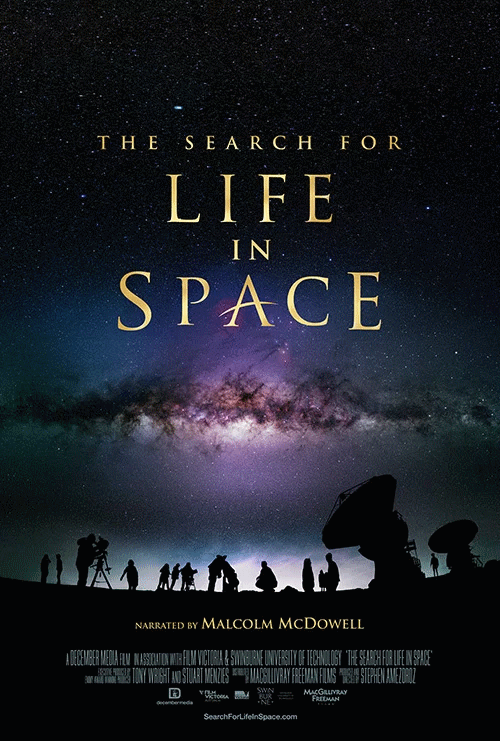
The Search for Life in Space
Journey from the depths of the Pacific Ocean into the far reaches of space on a quest to find something that changes everything…signs of life, somewhere else in the universe. With cutting-edge imagery from the world’s most powerful telescopes, The Search for Life in Space takes audiences from the surface of Mars and the icy moons of Jupiter and Saturn, to the extreme lava fields of Hawaii and thermal vents deep beneath the sea. In these harsh environments, astrobiologists look for clues to how life takes hold. As this immersive adventure into the universe reveals the possibility of planets like ours, The Search for Life in Space will make you re-examine such fundamental questions as: “Where did we come from?”, “How did we get here?” and “Are we alone?”
Teacher's Guide: LIS_Edu_Guide.pdf
Show Length: [42 minute show + 5 to 15 minute sky tour]
Intended Audience: Children/Families, Adults
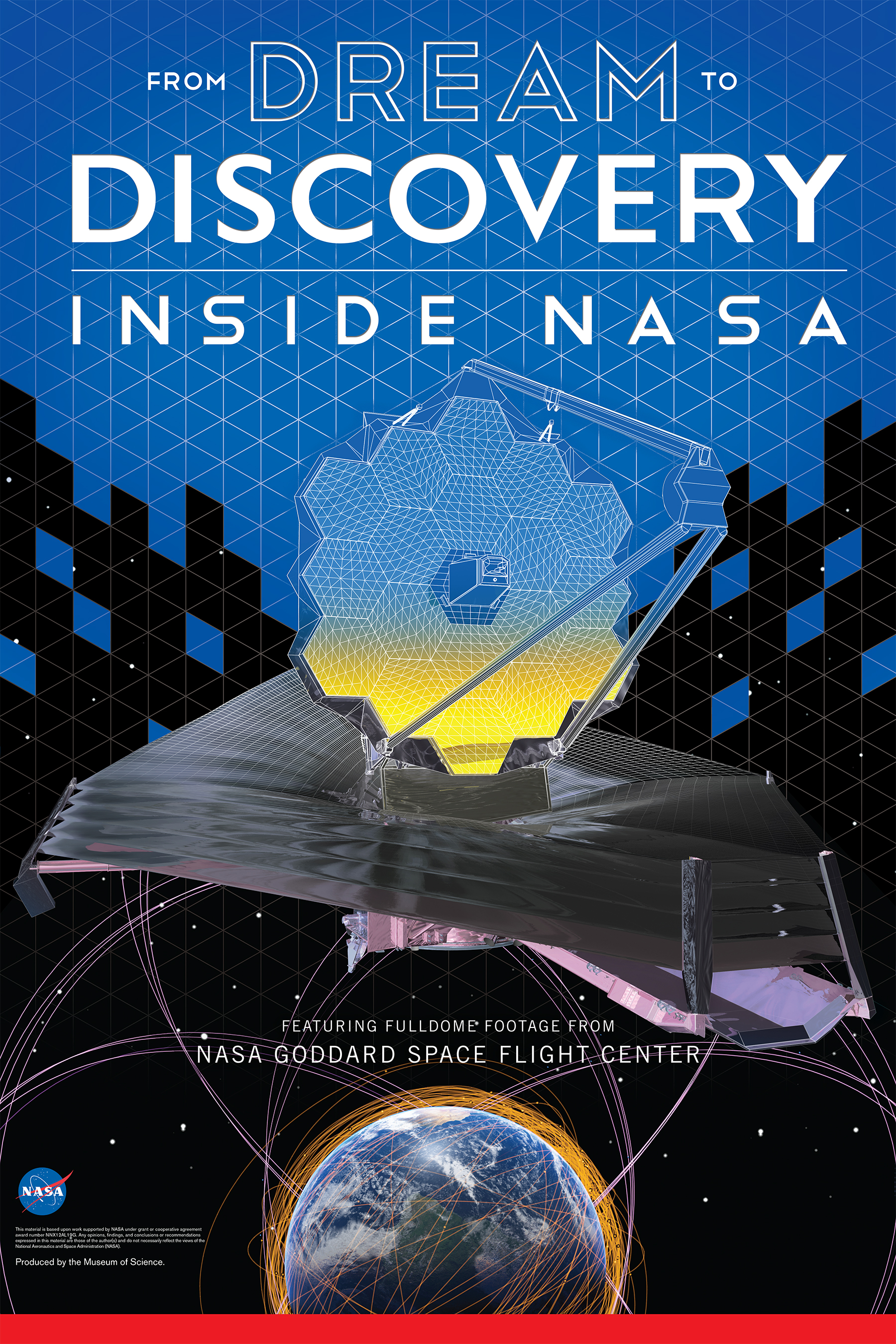
From Dream to Discovery
Journey from NASA’s test facilities all the way to Pluto and experience the excitement of engineers who design, test, and launch today's hottest missions into space.Journey from NASA’s test facilities all the way to Pluto and experience the excitement of today’s space missions. Immerse yourself in the adventures and extremes of spacecraft engineering—from the design of missions like the James Webb Space Telescope and New Horizons, to the rigors of testing, launch, and space operations. When humans dare to dream, we create truly amazing things.
Join NASA's engineers as they design, test, and launch today's hottest missions into space. Witness the enormity of the new James Webb Space Telescope, the intensity of Goddard Space Flight Center's testing facilities, and the excitement of the New Horizons mission to Pluto. From blueprint to blastoff, experience how unmanned space flight is pushing the frontiers of human exploration to the very edges of the universe!
Teacher's Guide: FromDreamtoDiscovery_edguide.pdf
Show Length: [35 minute show + 5 to 15 minute sky tour]
Intended Audience: Children/Families, Adults

Supervolcanoes
The award-winning Supervolcanoes examines rare and occasionally catastrophic eruptions, both on Earth and elsewhere in the Solar SystemSupervolcanoes is an immersive planetarium show that looks back at rare classes of eruptions that have marshaled the energy that lurks, like a sleeping dragon, beneath the surface of planet Earth. On a visit to a legendary North American hot spot, Yellowstone National Park, the film asks: can a supervolcano erupt in our time? The program then moves beyond Earth to explore the impact of giant volcanic eruptions around our solar system. Audiences will fly down to Neptune’s frigid moon Triton, and onto the ultimate volcanic world: Jupiter’s moon Io. Narrated by Benedict Cumberbatch.
Teachers Guide: Supervolcanoes_edguide.pdf
Show Length: [29 minute show + 5 to 15 minute sky tour]
Intended Audience: Children/Families, Adults
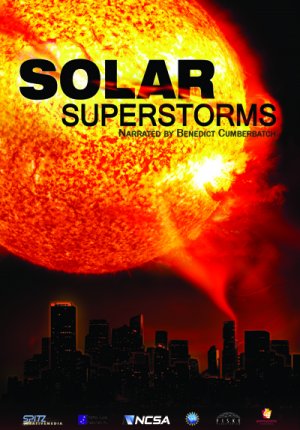
Solar Superstorms
Solar Superstorms explores the science of heliophysics, including Coronal Mass Ejections., auroras, solar flares, plasma, electric currents and the Carrington event. How will they affect planet Earth? Find the answers as we venture into the seething interior of our star.A fury is building on the surface of the Sun – high-velocity jets, a fiery tsunami wave that reaches 100,000 kilometers high, rising loops of electrified gas. What's driving these strange phenomena? How will they affect planet Earth? Find the answers as we venture into the seething interior of our star.
Solar Superstorms takes viewers into the tangle of magnetic fields and superhot plasma that vent the Sun's rage in dramatic flares, violent solar tornadoes, and the largest eruptions in the solar system: Coronal Mass Ejections.
The show features one of the most intensive efforts ever made to visualize the inner workings of the sun, including a series of groundbreaking scientific visualizations computed on the giant supercomputing initiative, Blue Waters, based at the National Center for Supercomputing Applications, University of Illinois.
Brace yourself for the onslaught of the next ... Solar Superstorm.
Teacher's Guide: SolarSuperstorms_edguide.pdf
Show Length: [29 minute show + 5 to 15 minute sky tour]
Intended Audience: Children/Families, Adults

Black Holes: The Other Side of Infinity
Black Holes: The Other Side of infinity explains how black holes are identified, what causes their formation and whether it's possible to use them for traveling through space.
Seen by millions worldwide, Black Holes: the Other Side of Infinity is one of the most successful fulldome shows ever produced. This cutting-edge production features high-resolution visualizations of cosmic phenomena, working with data generated by computer simulations to bring the current science of black holes to the dome screen. Audiences will be dazzled with striking, immersive animations of the formation of the early universe, star birth and death, the collision of giant galaxies, and a simulated flight to a super-massive black hole lurking at the center of our Milky Way galaxy.
Teacher's Guide: black_hole_edguide.pdf
Show Length: [28 minute show + 5 to 15 minute sky tour]
Intended Audience: Children/Families, Adults

Dark Universe
The universe is a curious place—more so than we ever imagined.
As scientists unravel the complexities of the cosmos, key findings are revealing amazing new frontiers for exploration. Come along on a journey about what we already know—and about the mysteries we have yet to solve—in Dark Universe, a Space Show from the Hayden Planetarium.
With astrophysicist Neil deGrasse Tyson as your guide, go beyond the night sky and into deep space to find out how discoveries over the past 100 years have led us to two great cosmic mysteries: dark matter and dark energy. You’ll hurtle through Jupiter’s atmosphere, peer at the web of dark matter holding galaxies together, and watch the colorful remains of the universe’s beginnings unfold.
Experience Dark Universe to celebrate the pivotal moments that have brought us unprecedented knowledge of the universe and our place in it—and glimpse the exciting future of cosmic exploration.Teacher's Guide: dark_universe_edguide.pdf
Show Length: [30 minute show + 5 to 15 minute sky tour]
Intended Audience: Children/Families, Adults

Dynamic Earth
Dynamic Earth explores the relationship between Earth and the Sun, life and the carbon cycle, Earth’s climate control system, and how human activities are changing our planet. Come learn how dynamic planet Earth really is!
Explore the inner workings of Earth’s climate system with visualizations based on satellite monitoring data and advanced supercomputer simulations. This exciting program follows a trail of energy that flows from the Sun into the interlocking systems that shape our climate: the atmosphere, oceans, and the biosphere. Audiences will ride along on swirling ocean and wind currents, dive into the heart of a monster hurricane, come face-to-face with sharks and gigantic whales, and fly into roiling volcanoes. We explore the relationship between Earth and the Sun, life and the carbon cycle, Earth’s climate control system, and how human activities are changing our planet. Come learn how dynamic planet Earth really is!
Languages Available: English and Spanish
Teacher's Guide: dynamic_earth_edguide.pdf
Show Length: [29 minute show + 5 to 15 minute sky tour]
Intended Audience: Children/Families, Adults

New Horizons
From breathtaking landscapes, to violent volcanic eruptions, to Saturn's icy rings, New Horizons transports you on a majestic journey through the planets and moons of our celestial neighborhood. Our journey begins as we follow a comet through interplanetary space. On each of our exotic ports of call, real data and images from modern space probes are transformed into stunning wrap-around visualizations.
Show Length: [27 minute show + 5 to 15 minute sky tour]
Intended Audience: Children/Families, Adults

Edge of Darkness
The Edge of Darkness features amazing scenes of places never before seen. Images and information were gathered by key space missions that culminated with groundbreaking discoveries in 2015. The show features a spectacular flight though the great cliffs on Comet 67P, a close look at the fascinating bright “lights” on Ceres, and the first ever close ups of dwarf binary planet Pluto/Charon and its moons.
Show Length: [28 minute show + 5 to 15 minute sky tour]
Intended Audience: Children/Families, Adults

Journey to the Stars
Journey to the Stars launches visitors through space and time to experience the life and death of the stars in our night sky, including our own nurturing Sun. Tour familiar stellar formations, explore new celestial mysteries, and discover the fascinating, unfolding story that connects us all to the stars. Features extraordinary images from telescopes on the ground and in space and stunning, never-before-seen visualizations of physics-based simulations. Those who come along for the journey may never see the night sky in the same way again.
Journey to the Stars is an engrossing, immersive theater experience created by the American Museum of Natural History’s astrophysicists, scientific visualization, and media production experts with the cooperation of the National Aeronautics and Space Administration (NASA) and more than 40 leading scientists from the United States and abroad.
Teacher's Guide: journey_to_the_stars_edguide.pdf4
Show Length: [30 minute show + 5 to 15 minute sky tour]
Intended Audience: Children/Families, Adults
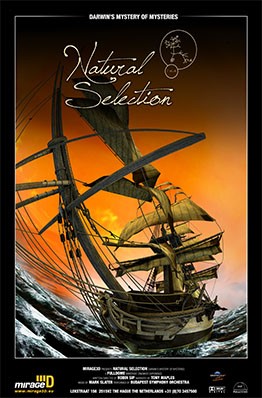
Natural Selection
The thrill of a scientific discovery, the adventure of science and the beauty of nature are central in this show. Join the young Charles Darwin on an adventurous voyage of exploration circumnavigating the World with the HMS Beagle.
In Victorian times many physical phenomena were already discovered and described by natural laws, but life's most eloquent mechanism was still unknown: How could new species arise to replace those lost in extinction? It was time for someone to stand up and come forth with a Naturalist explanation of this mystery of mysteries. Witness the thrill of scientific discovery by seeing the World through Darwin's eyes, make observations of the most beautiful natural scenery and let the pieces of the scientific puzzle slowly but surely fall into place. Allow Darwin himself to reveal this simple and most beautiful mechanism that explains the Evolution of all Life on Earth: Natural Selection, the single most wonderful idea anyone has ever had.
In Victorian times many physical phenomena were already discovered and described by natural laws, but life's most eloquent mechanism was still unknown: How could new species arise to replace those lost in extinction? It was time for someone to stand up and come forth with a Naturalist explanation of this mystery of mysteries. Witness the thrill of scientific discovery by seeing the World through Darwin's eyes, make observations of the most beautiful natural scenery and let the pieces of the scientific puzzle slowly but surely fall into place. Allow Darwin himself to reveal this simple and most beautiful mechanism that explains the Evolution of all Life on Earth: Natural Selection, the single most wonderful idea anyone has ever had.
Teacher's Guide: naturalselection_edguide.pdf
Show Length: [46 minute show + 5 to 15 minute sky tour]
Intended Audience: Families, Adults
Phantom of the Universe
Phantom of the Universe showcases an exciting exploration of dark matter, from the Big Bang to its anticipated discovery at the Large Hadron Collider.
The show reveals the first hints of its existence through the eyes of Fritz Zwicky, the scientist who coined the term “dark matter.” It describes the astral choreography witnessed by Vera Rubin in the Andromeda galaxy and then plummets deep underground to see the most sensitive dark matter detector on Earth, housed in a former gold mine. From there, it journeys across space and time to the Large Hadron Collider at CERN, speeding alongside particles before they collide in visually stunning explosions of light and sound, while learning how scientists around the world are collaborating to track down the constituents of dark matter.
Teacher's Guide: PhantomoftheUniverse.pdf
Show Length: [32 minute show + 5 to 15 minute sky tour]
Intended Audience: Children/Families, Adults

The Sun - Our Living Star
The Sun has shone on our world for four and a half billion years. The light that warms our skin today has been felt by every person who has ever lived. It is our nearest star and our planet’s powerhouse, the source of the energy that drives our winds, our weather and all life.
The passage of the Sun’s fiery disc across the sky — day by day, month by month — was the only way to keep track of time for countless past civilizations. Don’t be fooled by the terminology; although it is a typical dwarf star, the Sun consumes 600 million tons of hydrogen each second and is 500 times as massive as all the planets combined.
Discover the secrets of our star in this planetarium show and experience never-before-seen images of the Sun’s violent surface in immersive full-dome format.
Show Length: [30 minute show + 5 to 15 minute sky tour]
Intended Audience: Children/Families, Adults
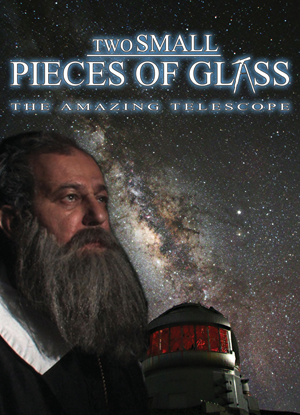
Two Small Pieces of Glass - The Amazing Telescope
"Two Small Pieces of Glass - The Amazing Telescope" show follows two students as they interact with a female astronomer at a local star party. Along the way, the students learn the history of the telescope from Galileo’s modifications to a child’s spyglass — using two small pieces of glass — to the launch of the NASA/ESA Hubble Space Telescope and the future of astronomy. Aiming to engage and appeal to audiences of all ages, the show explores the wonder and discovery made by astronomers throughout the last 400 years.
Teacher's Guide: tsp_teachers_guide.pdf
Show Length: [28 minute show + 5 to 15 minute sky tour]
Intended Audience: Children/Families, Adults
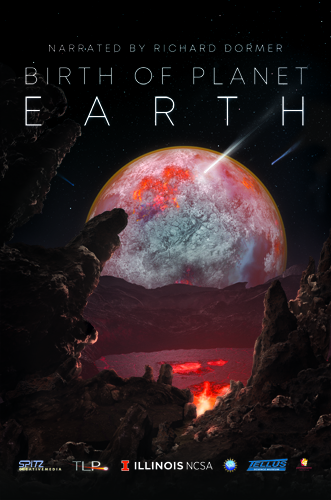
Birth of Planet Earth
Birth of Planet Earth looks at the very beginning of our planet and the unique requirements that enabled life to evolve. Visitors will journey billions of years back in time to see the countless supernova explosions that seeded our galaxy with planet-building elements. This material coalesced into giant gas and dust clouds, one of which collapsed to start the formation of our Sun and its planets. The details of the process are presented in spectacular immersive visualizations. The audience will witness the planetary construction process called accretion, the formation of the Moon when a Mars-sized object struck a very young Earth, meteor impacts that delivered massive amounts of water to our planet, and chaos in the inner solar system caused by the inward migration of the gas giant Jupiter. See how early one-celled bacteria survived by capturing the energy of sunlight which eventually led to more advanced plants that re-oxygenate the planet and power life on Earth.
Teacher's Guide: BirthofPlanetEarth_edguide.pdf
Show Length: [30 minute show + 5 to 15 minute sky tour]
Intended Audience: Children/Families, Adults
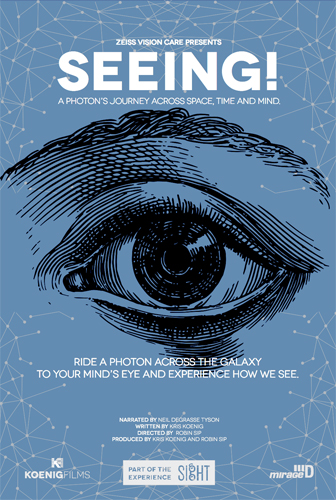
Seeing! A Photons Journey Across Space, Time and Mind
SEEING! begins with a photon’s creation inside a distant star. We then follow its immense journey across the galaxy into the eye of a young stargazer. As the photon enters, we learn about the structures of the eye, their functions and we ride along the optic nerve. The photon's energy is converted into electrochemical impulses that travel the neurochemical pathways of our brain, resulting in an image in our mind. Also addressed are the ways technology enables us to restore vision and prevent various diseases that affect sight. Stunning 360° visuals of landscapes, skyscapes, wildlife, humanity and space are used to tell the story of light, sight and vision. Dr. Neil deGrasse Tyson, American astrophysicist, cosmologist, author, science communicator, narrated SEEING!.
Teacher's Guide: SEEING_edguide.pdf
Show Length: [31 minute show + 5 to 15 minute sky tour]
Intended Audience: Children/Families, Adults

Secret Lives of Stars
Some stars are massive. Others are tiny, almost insignificant. The specific characteristics of a star will determine what type of life it will lead and how long it might live. Audiences will witness the amazing variety of stars and peer into their secret lives.Not all stars are created equal. Some are massive. Others are tiny; almost insignificant. The specific characteristics of a star will determine what type of life it will lead, how long it might live and even the type of death it will die. We will witness the amazing variety of stars and peer into their secret lives. Narrated by Sir Patrick Stewart of TV's Star Trek: The Next Generation and the X-Men films. Winner of 4 Telly Awards.
Show Length: [32 minute show + 5 to 15 minute sky tour]
Intended Audience: Children/Families, Adults

Supermassive Black Holes: Uncovering the Invisible
Leading scientists in observational and theoretical studies of black holes and galaxies, industrial experts in cutting-edge big technologies, and professionals in science dissemination have been brought together to set up research projects which will combine the latest state-of-the-art observations, numerical simulations and innovative analytic tools to compare theory with observation, and shed light on the physics of black hole formation in the context of galaxy evolution. This planetarium show presents the environments of the black holes in an impressive and understandable way to the audience.
Show Length: [21 minute show + 5 to 15 minute sky tour]
Intended Audience: Children/Families, Adults

PowerPoint Presentation
This reservation is for guest speakers with PowerPoint presentations within the College of Sciences and Mathematics only. It uses the built-in rectangular projector rather than the 2 projectors which cover the full dome. Please check your email for after making a reservation to make sure the planetarium is available. There are no charges for PowerPoint presentations.Intended Audience: All

CoSM Dean's Office Reservation
This reservation is for use by the CoSM Dean's Office. Please check your email for after making a reservation to make sure the planetarium is available. There are no charges for CoSM Dean's Office reservations.Intended Audience: All



































